Did you know that over 60% of music apps launched in the past five years never make it past year one? Or that app store churn for streaming platforms sits above 35% within three months?
Having guided countless projects through these rocky waters, we’ve learned that success in the music app world isn’t just about killer playlists; it’s about avoiding hidden pitfalls.
In this blog, we’ll share eye-opening stats, real-world missteps about why music apps fail and help you with some insider strategies to save you from common traps.
By the end, you’ll have a clear playbook for building a music app that users stick with and rave about.
The Online Music App Scene
Before exploring the reasons behind failures, let’s set the stage.
The music streaming market is growing tremendously, with platforms like Spotify, Apple Music, and YouTube Music leading the charge.
But what exactly is a music streaming platform? Simply put, it’s a digital service that delivers on-demand audio to listeners over the internet, no downloads required.
And the audience is massive.
Over 678 million active listeners tune in each month on Spotify alone, while 70% of smartphone users stream music at least once a week.
From commuting playlists to workout beats, these apps have become the go-to for millions.
With such huge potential, it’s no surprise that many startups rush to develop a music app and chase a piece of the streaming pie.
Yet alongside the giants, dozens of smaller players launch with big dreams only to fizzle out faster than a one-hit wonder.
In the sections ahead, we’ll uncover the reasons that cause music app failure and share insights on how to stay in tune with user expectations.
Why Music Apps Fail?
The music streaming industry may seem like a goldmine, but scratch beneath the surface, and you'll find a different tune.
While a few giants dominate the charts, hundreds of music apps vanish quietly every year.
Their stories rarely make headlines, yet they offer valuable lessons for founders, developers, and investors alike.
What makes a music app fail isn't always about bad ideas. Often, it's the execution, market fit, monetization model, or even poor user experience that leads to collapse.
Let’s break down the top reasons music apps don’t succeed, so you can learn from their missteps and build something that truly resonates.
1] Lack of Differentiation in a Crowded Market
In a space flooded with similar offerings, standing out is non-negotiable. Most apps launch with standard playlists, a search bar, and maybe a few “exclusive” tracks, features users already get from top players.
Failing to innovate leads to low downloads, minimal engagement, and ultimately, music app failure. Without a strong hook or niche positioning, your app fades into obscurity.
What it causes: Low visibility, weak brand recall, and high acquisition costs with little ROI. This is often the top reason music apps don’t succeed.
If you're entering this space, researching music app trends is crucial to spotting gaps and avoiding redundancy.
2] Weak Monetization Strategy
Many music apps launch with a freemium model, assuming users will convert to paid plans.
But without offering real value or exclusive content, there's no incentive to upgrade. Others over-rely on ads, which frustrate users and lead to uninstalls.
What it causes: Revenue dries up quickly. Developers struggle to maintain servers or update the app.
Not having a good music app monetization model can be a leading contributor to music app failure in its early stages.
If you're estimating the cost of developing a music app, make sure monetization is baked into your roadmap from day one.
3] Poor Licensing & Legal Oversight
Licensing music is expensive, time-consuming, and often underestimated.
Many developers assume open APIs or loopholes will suffice until they receive takedown notices or face lawsuits. Even royalty-free content comes with complex usage rights.
What it causes: App store removals, fines, or even shutdown.
Legal missteps are one of the most overlooked reasons for music app failure, especially among indie developers and new startups.
Always include legal consultation when planning your launch.
4] Low User Retention and High Churn
Getting downloads is easy. Keeping users? Not so much.
If users don’t find value immediately, they abandon the app without exploring further. Slow load times, clunky UI, or lack of personalization are instant dealbreakers.
What it causes: Poor app store ratings, weak DAUs (Daily Active Users), and ultimately, high churn.
This is a silent killer behind why most music streaming apps fail. For new founders, investing in UX and onboarding should be a top priority.
5] Unscalable Tech Stack
Many apps are built quickly using low-cost frameworks that aren’t meant for growth.
While they might work for MVPs (minimum viable products), these stacks often crash or lag when user load increases or new features are added.
What it causes: Frequent downtime, bugs, and poor reviews. Scalability is one of the biggest challenges in developing a music app.
Apps that can’t evolve technically rarely survive the growth phase, leading to eventual failure.
6] Inadequate Music Discovery & Personalization
Today’s users expect intelligent recommendations, mood-based playlists, and intuitive discovery.
Apps that fail to provide this feel static and outdated, making it hard for users to build a long-term relationship with the product.
What it causes: Low listening time, poor session length, and low engagement metrics.
This is a direct contributor as to why music apps fail, as retention heavily depends on how well you understand and serve user taste.
Using AI or ML-based suggestions is no longer optional; it’s expected.
7] Overlooking Offline & Low-Bandwidth Support
Music is a universal need, but not every user has 5G access.
Apps that ignore offline downloads or don't perform well on slow connections alienate large user bases, especially in emerging markets.
What it causes: Loss of potential users and poor experience in non-urban areas.
This restricts your growth early on and is one more reason why online music startups don’t succeed. Offline mode is now a must-have, not a luxury.
8] No Community or Social Layer
In the age of social audio and music fandoms, having no interaction features is a missed opportunity. Apps that lack likes, comments, collaborative playlists, or social sharing fall behind quickly.
What it causes: Shallow engagement and low emotional investment.
This makes it harder to build brand loyalty. In a world of apps like TikTok and Discord, building a music app without a community is a mistake many startups make, leading to preventable music app failure.
9] Burnout from Poor Financial Planning
Even well-designed apps crash financially. Whether it's underestimating server costs, overpaying for marketing, or running out of runway before hitting monetization goals, many music apps simply burn out before they scale.
What it causes: Cash flow problems, halted development, and layoffs. If you're planning to start an online music business, financial modelling isn’t just a formality; it’s your survival strategy. Apps that don’t plan long-term fail long-term.
10] Not Adapting to Evolving Tech Trends
Many music apps launch and remain stagnant.
They fail to leverage advancements like AI in music apps, machine learning for personalized playlists, or NLP for seamless voice commands, falling behind as user expectations grow.
What it causes: Outdated UX, low retention, and missed chances for innovation.
In a market driven by intelligent experiences, ignoring trends like AI in music apps can leave even well-designed platforms irrelevant and easily replaced.
Let’s move this to understand more in-depth about those apps that died throughout the years or were completely damaged.
Music Apps That Failed in the Market: Four Case Studies
Around 85–90% of music streaming startups fail within just 2–3 years.
While demand keeps rising, only a few become top music apps; most fade due to poor retention, lack of innovation, or technical flaws.
Studying these failures shows what separates lasting platforms from those that disappear quietly.
Looking at real-world failures reveals what went wrong and how future apps can avoid the same fate.
1. Guvera
Backed by more than $180 million in funding, Guvera attempted to offer free ad-supported music streaming with a focus on brand-based content delivery. Operating in multiple countries, it looked promising but eventually collapsed.
-
- Why it failed: Guvera over-relied on an unstable monetization model, expanded too quickly, and struggled with legal and financial transparency. When it attempted to list on the Australian Securities Exchange, it was denied due to ongoing losses.
- Impact: It burned through investor funds without proving its sustainability, showing how overconfidence without product-market fit is a recipe for disaster and shut down in 2017.
2. Ping by Apple
Apple Ping was a social music network embedded into iTunes that shut down in 2012.
With Apple’s reach and infrastructure, Ping had everything going for it except community appeal.
The platform was confusing, offered limited interaction, and didn’t integrate well with users' actual social lives.
-
- Why it failed: Weak engagement mechanics, no integration with external social platforms, and unclear user value.
- Impact: Even big tech isn’t immune to music streaming app failure when user behaviour is misunderstood.
3. Samsung Milk Music
Launched as a free, ad-free alternative with curated content, Samsung’s Milk Music lasted just two years & closed in 2017. Despite high-quality music curation, it struggled to differentiate itself in the U.S. market.
-
- Why it failed: Limited availability, zero cross-platform support, and lack of standout features compared to Spotify or Pandora.
- Impact: Proved that great curation alone isn’t enough—you need reach, brand loyalty, and platform consistency.
4. Twitter Music
This standalone app aimed to recommend songs based on Twitter activity and trends. Despite Twitter’s vast user base, the product lacked depth and user traction and was pulled from the App Store by Twitter in 2013.
-
- Why it failed: Shallow catalogue integration, poor UX, and minimal personalization.
- Impact: What is the failure rate of music streaming startups? Apps like Twitter Music show that even with a massive audience, a lack of true utility can sink a product fast.
For someone who wants to start an online music business, it is important to turn failures into actionable insights.
Below are the lessons learned and best practices that can help ensure your music app not only survives but also stands out in a saturated market.
Best Practices to Ensure a Successful Music App
What causes music apps to fail? The answer often lies in a mix of ignored details and critical oversights, rushed development, weak monetization, poor UX, or legal gaps.
However, the success stories that do emerge all follow a few consistent best practices. By reverse-engineering failure, we can build a path toward success.
Below are the best practices every music app team should follow to avoid becoming another statistic in the long list of abandoned or uninstalled apps.
► Validate the Idea with a Niche Audience
One of the top causes of online music app failure is the “build it and they will come” mindset.
Many teams create apps based on trends instead of actual user problems. They launch too broadly, trying to be everything to everyone, and end up resonating with no one.
Best Practice: Before building your music app idea, consider whether it’s regional indie music lovers, lo-fi producers, or fans of 8D sound.
This gives your product a strong direction, makes marketing easier, and helps you stand out.
► Secure Licensing Before Launch
Music apps often fail due to underestimating how hard it is to legally stream music.
Some teams launch with unlicensed content or vague partnerships, thinking they’ll “figure it out later.” But music rights are layered, expensive, and unforgiving if handled incorrectly.
Best Practice: Work with music licensing aggregators and secure the proper rights before you write your first line of code. This avoids legal nightmares and builds trust with artists and users alike.
► Invest in User Experience & Personalization
The primary reason music apps fail is poor user retention and that often boils down to how the app feels. Generic interfaces, slow loading, and irrelevant recommendations can kill first impressions.
Best Practice: Focus on onboarding, personalization, and design consistency.
Use listening history to recommend songs. Let users customize their home screen. Treat UX as a revenue-generating asset, not just design polish.
► Build a Scalable, Future-Proof Tech Stack
Here are the key mistakes developers make when launching a music app: choosing low-cost backend systems, skipping QA, and ignoring scalability.
When thousands of users sign in, your app must be prepared to stream content flawlessly.
Best Practice: Choose frameworks and tools that are cloud-scalable, low-latency, and support offline caching. Real-time audio streaming needs robust infrastructure; don’t cut corners.
► Monetize Strategically from Day One
If your music app is failing, it’s likely because you launched without a real plan to generate revenue. Relying on ads alone won’t work unless you have massive user numbers.
Subscription fatigue is also real, so your premium tier must deliver clear value.
Best Practice: Offer multiple monetization models, including freemium, premium, artist tipping, or even NFT-based ownership.
Build pricing models based on your target users. Learn from other platforms that struggled, and incorporate pricing tests early on.
Don’t forget to assess this as part of the cost of developing an app from the start.
► Build Community and Social Features
To prevent music app failure, avoid these common pitfalls: ignoring the emotional and social side of music.
Music isn’t just content, it’s a shared experience. Apps that don’t tap into this lose out on deeper engagement.
Best Practice: Include playlist sharing, friend feeds, and even artist-to-fan interaction features. Let users feel like they’re part of something bigger.
Music communities drive repeat visits, longer sessions, and organic virality.
► Use Data to Iterate Constantly
A post-launch freeze is a death sentence. If you’re not learning from user behaviour such as song skips, bounce rates, and favourite genres, you’re operating in the dark.
Best Practice: Create feedback loops with analytics. Run A/B tests on UI changes, content placements, or new features. Allow space for evolution.
This reduces churn and increases your chances of becoming one of the top music apps, not a failed one.
Knowing these best practices are important but not sufficient as you will need expert mobile app development company in Denver by your side.
Why JPLoft Is the Right Tech Partner to Build Your Music App Idea?
Turning a great idea into a successful music app takes more than just code; it takes vision, strategy, and the right partner. That’s where JPLoft comes in.
As a trusted music app development company, we don’t just develop apps, we craft engaging, scalable experiences that users love.
From concept validation to UI/UX design, backend development, and post-launch support, we walk with you at every step.
Whether you're building for indie artists, playlist curators, or global audiences, we help your idea stand out in the crowded streaming space and stay there.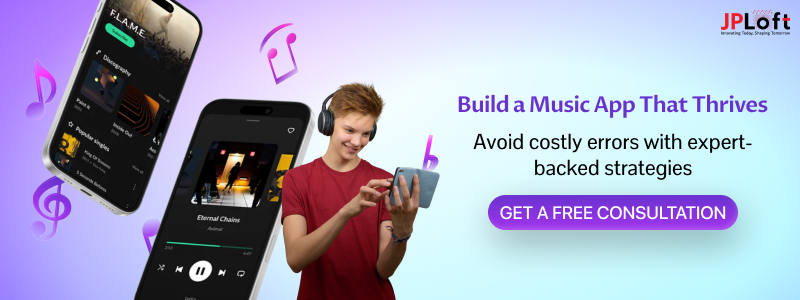
Conclusion
Creating a music streaming app is like producing a hit record, it takes more than passion. It demands precision, strategy, and an ear for what the audience truly wants.
As we've seen, why music app startups fail often boils down to poor planning, weak retention strategies, and ignoring legal or technical foundations.
But with the right approach, your app doesn't have to become just another one-hit wonder.
Learn from past failures, build with intent, and collaborate with a seasoned development partner to create an app that hits all the right notes and stays on the charts for good.
FAQs
Most apps fail due to poor market research, lack of product-market fit, and low user engagement. In the music space, failure often comes from ignoring UX, monetization, or technical scalability, leading to high churn and unsustainable growth.
Guvera is a well-known example. Despite raising over $180 million, the app was denied listing on the Australian Securities Exchange due to mounting financial losses and a lack of profitability, effectively leading to its closure and ban from further trading.
To stand out, focus on a niche audience, offer strong personalization, and introduce features users can’t find elsewhere. Unique discovery tools, offline support, or creator monetization options can set you apart from the competition.
Absolutely. Without proper music licensing, your app risks legal action, takedowns, and permanent suspension. Always work with a licensing aggregator or legal consultant to ensure full compliance before launch.
The major causes of online music failure include poor monetization strategies, lack of user retention features, legal oversights, unscalable tech architecture, and ignoring user feedback. Many startups also fail to define a clear niche, leading to low visibility and weak engagement in an already saturated market.





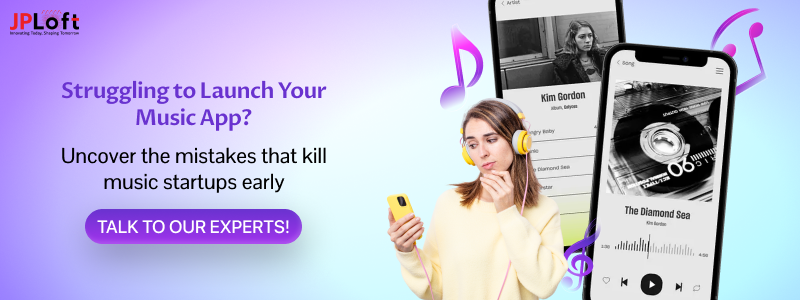

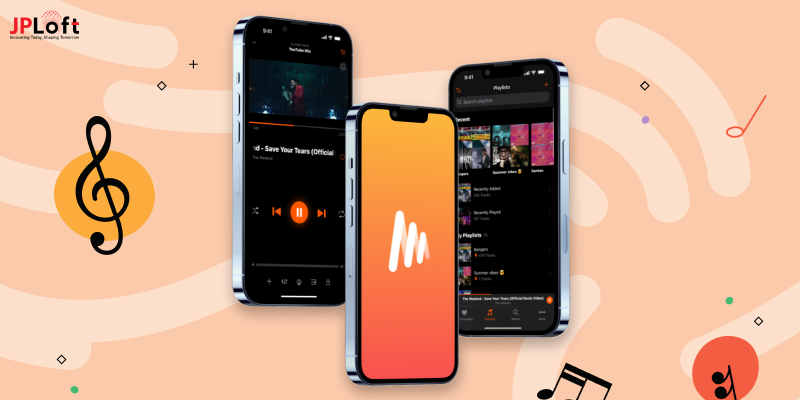
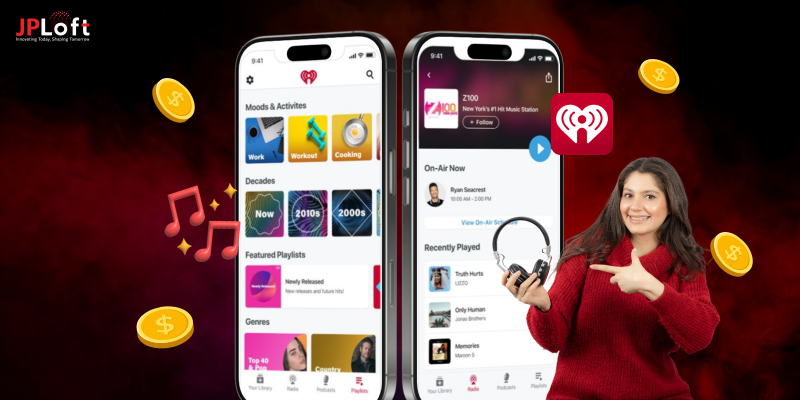
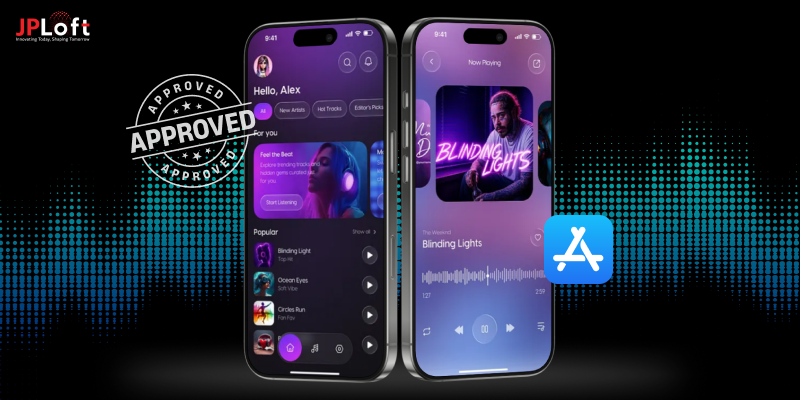


Share this blog